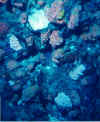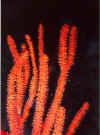NIGHT DIVES!?!?
You dive into the ocean at night?!
In the dark?!
Do you know how big the ocean is?
Do you know how dark the ocean is at night?
Do you realize what is out there in the dark that could eat you?
Do you realize that most sea creature feed at night?NIGHT
DIVES!?!?
ARE YOU NUTS?!?!?
I am well aware of how big and dark the ocean is and what lives and
feeds at night down there; but at night everything changes. Creatures that you would never
see in the day come out. The most spectacular thing to me is how many of the coral change
at night. Coral that may look plain and drab in the day is the most colorful, radiant
coral at night. It actually blooms when the sun goes down. If you don't take chances, you
will miss out on a lot in life. Nowhere is this more true than in exploring the world
under the seas.
* See WARNING at bottom of page.
Click on some of the thumbnails below to get a better view of what I am
talking about. |
 |
If you are only a day diver, you will see some
coral that looks like this. It is very interesting looking in the day. It looks kind of
green, aqua or blue with shades of pink or orange at times. It appears to have a circular
design with little pitted areas. It looks like colored, dimpled rocks. But look at the two
pictures below to see what you will find at night if you visit this same sight. |
 |
If you didn't know better, you would never know
that this was the same coral you were looking at above. It is a closer view of one of the
areas seen above, but at night. These daisy coral only bloom at night. One of the stems
comes out of each of those circular indentations that you see in the day. |
 |
This is another patch of these night daisies
blooming. Sometimes they are a bright orange. They come out at night and feed on small
particles that drift by in the darkness. So not everything that feeds at night is big and
spooky. |
 |
This coral looks smooth and brown in the daylight,
but at night it grows a little fuzzy looking "coat" of villi that absorbs
nourishment before retracting at the first sign of dawn. |
 |
If you are brave enough to dive on the
"Yongala" in the day, you will see lots of beautiful dark purple coral growing
on the hull of the ship. It is soft coral that looks fluffy. |
 |
But an even greater prize lies in in store on this
fabled wreck for those who have the nerve to visit her at night. The fluffy purple coral
appears bright red with an even fuller, thicker bloom.
And anyone who knows me, knows that red is my favorite color. |
 |
This is just another example of the beautiful coral
that is appreciated only by the night divers.
|
Do night divers forget about the
dangers of dark deep ocean? They had better not.
If you ever get too comfortable or start to forget what is swimming with you, all you have
to do is shine your light out into the deep darkness and you quickly reminded that you are
not alone when you see reflections of green, orange or red eyes looking back at you. They
are always out there. They are always watching. You are a visitor in their world. You have
to remember that and respect them.
But if you never go in the seas at night, you will not see some of her most beautiful
creatures.
*WARNING!
If diving into the ocean at night makes you feel a
little uneasy,
DO NOT DO IT.
This page is not intended to encourage people who might not feel comfortable, for any
reason, to make a night dive. There are lots of dangerous things that live in the ocean,
but most dangerous thing for a scuba diver is not in ocean. It is in your head.
Panic will cause the death of more scuba divers than sharks, sea snakes,
lionfish, jellyfish and all other sea creatures put together. When panic attacks, you
loose the ability to think logically and you are more apt to make a mistake
that could cost you your life.
Never dive under conditions beyond your level of training or that you are not totally
comfortable with. If you are nervous about diving at night, stay out of the water and come
here to see what you are missing. |